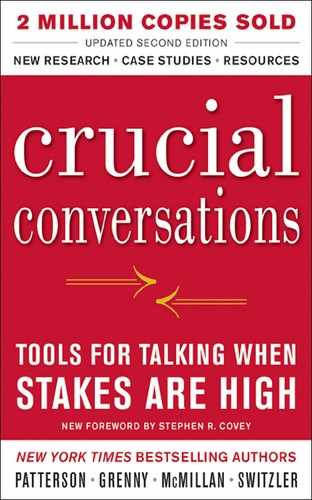RON
Over the last ten years, I’ve been amazed at the powerful, positive impact that Crucial Conversations principles and skills have had on organizations’ results and peoples’ lives. We have a marvelous collection of personal stories, business cases, and research studies proving the efficacy of these skills. I have overwhelming confidence in their power and utility. But, I am frequently reminded of a sobering, balancing lesson:
If you do everything we tell you to do in this book, exactly the way we tell you to do it, and the other person doesn’t want to dialogue, dialogue will not take place.
The other person has the ability to choose how to respond to your efforts. These skills are not techniques for controlling others; they are not tools for manipulating behavior or eliminating others’ agency. These skills have limits and do not guarantee that other people will behave in exactly the way you desire.
Now, before you demand your money back for the price of the book, consider another lesson I’ve learned. The title of the book is Crucial Conversations; “conversations” is plural, meaning many, not one. The temptation is to think of a crucial conversation as “my one chance to solve this problem” or as “the one conversation needed to save a relationship” or as “the one opportunity to make everything right.”
What if, instead, we see the single crucial conversation as the beginning of a dialogue—the first step toward making a negative relationship positive, the first of many steps necessary to right a wrong? What if we seek to have not just a conversation based on Mutual Purpose and Mutual Respect, but rather a rich relationship based on these conditions? To see these principles and skills as ways of building relationships, teams, and families over time is to take a longer-term perspective. The wisest use of these skills is to develop habits, lives, and loves, not to use them just occasionally in single interactions.
Years ago, I had serious concerns about one of my teenage daughters. She had always been a straight A student, but then her grades tanked. She started bringing home Cs and Ds. Her grooming degraded. After school, instead of hanging out with her friends, she stayed in her room alone. I knew something was very wrong.
My repeated efforts using my very best skills to get her to talk were rebuffed with icy silence or sullen one-word replies. When she did initiate a conversation, it was only to complain or make a sarcastic comment.
It would be easy to see my crucial conversations with my daughter as failures—not a single one created a dialogue with her or solved a problem. And yet, consistently applied principles can have a strong influence over time. Every heartfelt attempt on my part to talk with her made it safer for her. Each time I replied to her sarcastic remarks with respect, safety was nurtured. Every time I stopped probing before she felt overwhelmed, I showed respect for her privacy. When I shared my good intentions and offered to be of help, her negative stories softened.
Then came the memorable moment. After several weeks of patient effort, when she felt safe enough, she approached me, shared her problem, and asked for my help. Our conversation created understanding and options, and gave her the resolve to pursue them.
If you use these skills exactly the way we tell you to and the other person doesn’t want to dialogue, you won’t get to dialogue. However, if you persist over time, refusing to take offense, making your motive genuine, showing respect, and constantly searching for Mutual Purpose, then the other person will almost always join you in dialogue.
